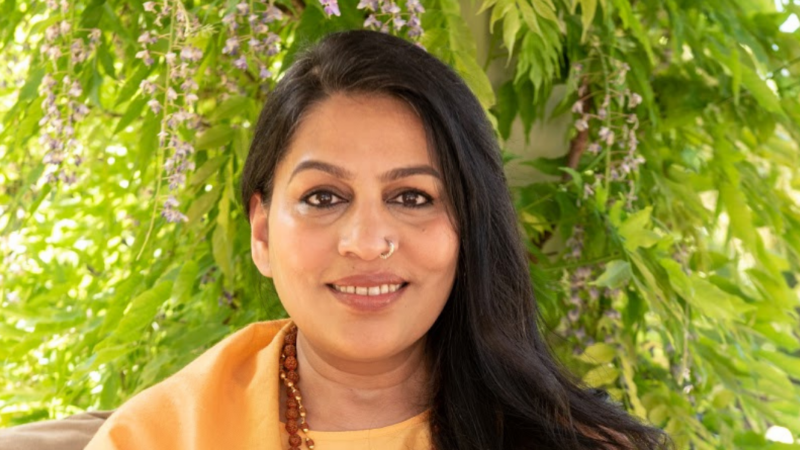Meet The Author of Sovereign Self
The Author
Acharya Shunya is an award-winning and internationally renowned spiritual teacher and scholar of Advaita (nondual wisdom) and a classically-trained master of Yoga and Ayurveda. The first female head of her 2,000-year-old Indian spiritual lineage, she has dedicated her life to the dissemination of Vedic knowledge for the spiritual uplifting of all beings. She is the president of the Awakened Self Foundation with its international headquarters in San Francisco and founder of the spiritual nonprofit Vedika Global. Learn more at acharyashunya.com.
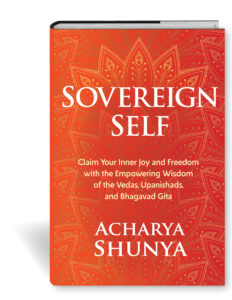 The Book
The Book
A comprehensive guide to yoga’s most influential texts, making their profound teachings both accessible and immediately practical for modern seekers. Filled with hidden insights and engaging guidance, Sovereign Self will help you awaken and recognize your potential to be joyful, resourceful, abundant, limitlessly expansive, and sovereign.
Show us a day in your life.
I lead the life I want to lead, every day, my heart leading me, and not because I must.
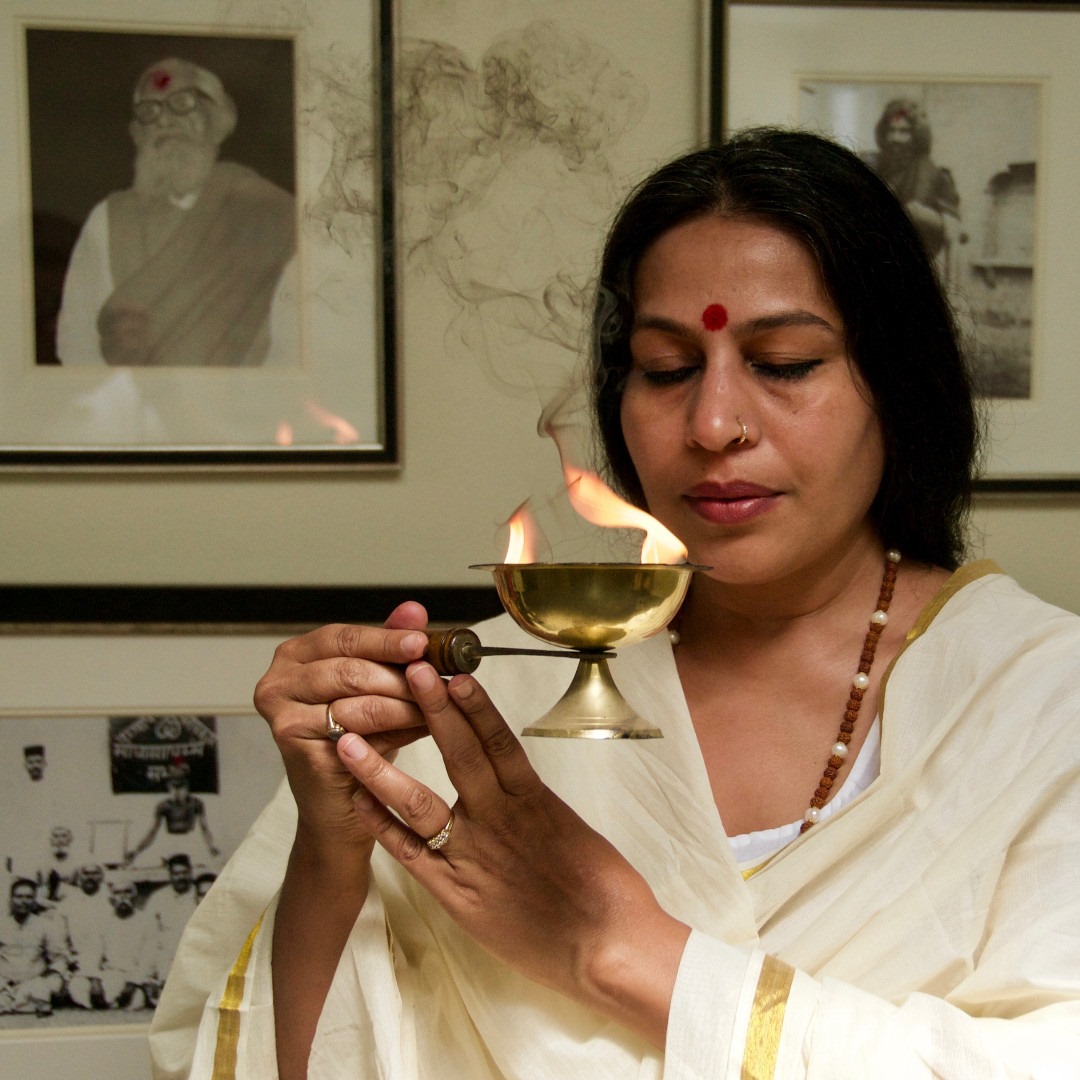

In the early morning I say a prayer of gratitude to my guru and meditate on the beautiful and divine, forever sovereign presence in my heart, that is my true Self.
Self rises silently in meditation to fill my heart with light, and bless me from within. I become, as if renewed, to meet my day with my spiritual power, full on.
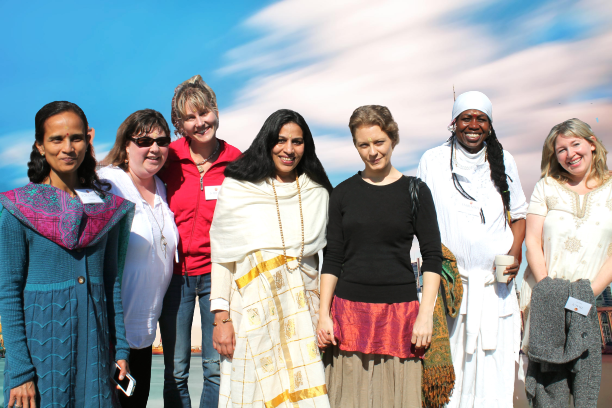
Many spiritual seekers and members of my Vedic lineage often join me through my day.
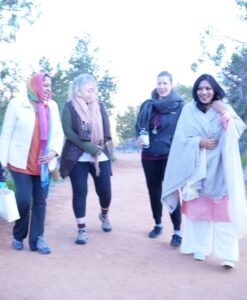


I go hiking with students, lead them through meditations, and impart Vedic wisdom from my 2000-year-old Vedic lineage from India.

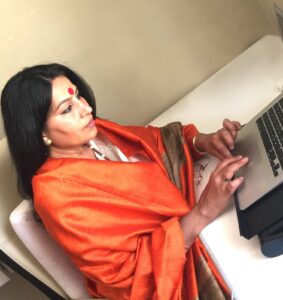

From lunch onwards, I like to be mostly by myself in my study, to think and imagine, to feel and to surrender to my higher Self, and capture my inspiration in words. On many days, I spend time in Vedic ceremony and its consciousness awakening inner rituals and meditations.
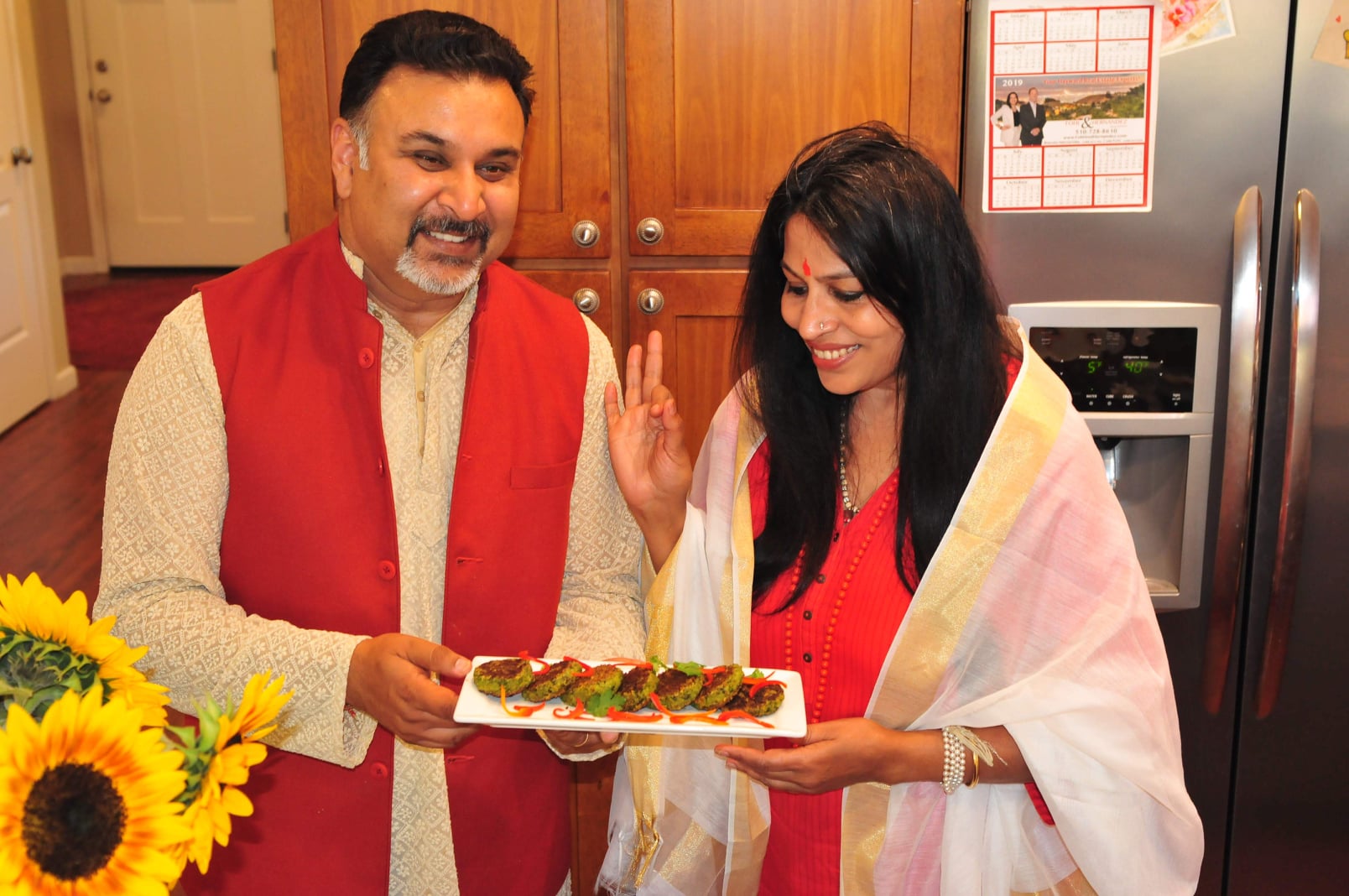
I also value spending time with my husband. Sanjai is a trained Ayurveda chef. Here we are enjoying the fruits of his labor in our kitchen.
Has your book taken on a new meaning in the world’s current circumstances? Is there anything you would have included in your book if you were writing it now?

In today’s uncertain world, embracing one’s unimagined power can open up possibilities as we synchronize with our true Self.
According to the Vedas, Upanishads, and Bhagavad Gita—India’s oldest body of sacred yogic wisdom—human beings can be inspired to awaken from conditioning, shed limiting patterns and shackling attachments, and tap into the wisest, boldest, and most authentic and fearless parts of ourselves—which dwell as an invisible potential inside our heart, called Atma, the boundless one. This mighty Self, with all its hidden powers, becomes activated through right knowledge, meditations, and insights, making us true masters of our destiny, able to forge a path of sovereignty in every circumstance, good or bad.
Knowing the sovereign Self in our heart can alter the course of our life; this Self-knowledge can become a source of inner equanimity in any circumstance in life, not only when life is fun and people around us are acting supportively and lovingly, but also when life is unpredictable and people’s behavior is shadowy and dark.
Naturally, this book has taken on a new meaning since I wrote it because today, our world is besieged by uncertainty and possibilities of disease; death is stalking each one of us, invisibly. To add to our collective sense of anxiety, we’ve also witnessed one of the most polarized elections in this country’s history. Social and racial injustice is at an all-time high. Our reality and our values stand to be changed forever. Now, more than ever, the sanctuary beyond fear and impermanence lies within the rediscovery of our true, invincible nature.
If you are a sensitive and evolved soul who believes in dharma, nonviolence, equality, and justice for all, my book, Sovereign Self, will be like a balm to your soul, a flame lit softly in a pitch-dark room—a path revealed, where none existed before.
Share a photo of you and your pet. Did your pet have a role in helping you write your book?
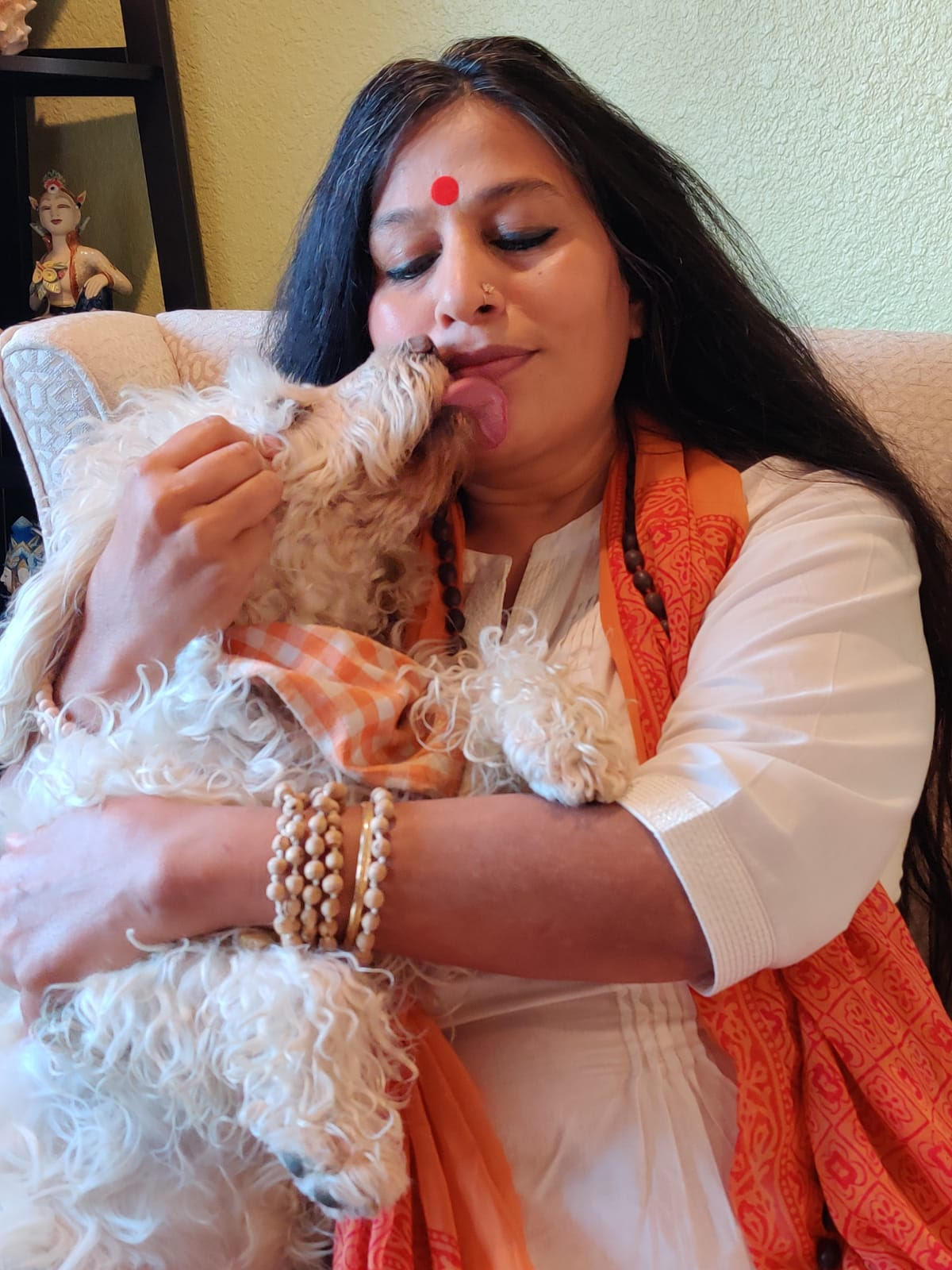
Noddy, my six-year old labradoodle, has been my constant companion through the writing of Sovereign Self, which took almost three long years. The process required me to let go and descend deep within the mystical realms of my being, and connect with the true Self—the boundless essence, Atma, which I talk about in my book.
It is from here, from that boundless essence where I have always been perfect, complete, and inseparable from Source, that ideas would emerge spontaneously and words would become sentences that shall become path-showers for seekers all over the world. Many times, I would meditate and be lost in trance for hours. Noddy would sit patiently by me, and even sacrifice his desire to bark at his arch-enemy, “Mr. Squirrel.” As long as my eyes were closed, my baby would be quiet as a mouse. But the moment my eyes opened, he would greet me with an explosion of love and affection: “Woof, woof, welcome back to my world, mama; how was your inner world, mama, did you find me in your heart, mama?”
Noddy and our next-door neighbor’s German Shepherd, Peet, have unresolved karmic issues from a relationship in their former lifetime. As a result, whenever Peet barks, Noddy barks back with recognition and emotional resolve to sort the karma issues in this lifetime itself! As I wrote and talked about the human ego and how it becomes lost in the chase of relationships and things, the experience of watching them go back and forth in their dance of egos, through playtime and tug-time and wagging-tail-time and angry growl-time, made me smile, and reminded me that we really are always enough in who we are. This is what Noddy means to me—when he kisses me with all his inner sweetness intact, he reminds me that while my ego may be employed in worldly tug-of-wars, my true Self remains whole, happy, and incredibly sweet within. Noddy, you are such a reminder!

Learn More
Sounds True | Amazon | Barnes & Noble | Indiebound | Bookshop
A Path to Embodied Nonduality
We find ourselves in a time that is rich with paths toward spiritual awakening, especially that pinnacle of awakening called “nonduality.”
The Fullness of the Ground is my contribution to that abundance. It describes in detail the lived experience of nondual realization.
In the book, I offer a series of gentle attunement practices, called the Realization Process, for uncovering and knowing ourselves as a fundamental, undivided dimension of consciousness, pervading our whole body and environment. Pervading our body, fundamental consciousness is experienced as the authentic ground of our individual being. Pervading our body and environment, it is the basis of our oneness with everyone and everything around us. This means that we become whole as individuals at the same time as we transcend our individuality and experience unity with our surroundings.
As a longtime spiritual teacher and psychotherapist, I feel that there is not enough emphasis in some of the nonduality teachings about how this realization enriches our lives. I have been particularly concerned about teachings that encourage people to disconnect from themselves as individuals or to suppress their emotional responses to the world around them. In this book, I instead offer a path to nondual realization that is deeply embodied and that matures us as individuals, at the same time that it opens us to self–other oneness. Far from erasing us as individuals, nondual realization enhances our experience of our own unique existence. It deepens all of our human capacities, including our ability to feel, to think, and to enjoy our lives. It can help heal and enhance our relationships with other people by enabling us to experience deep contact with others without losing inward contact with ourselves.
Central to the method in this book is the important difference between being aware of the body and inhabiting the body. So I often begin with this simple exercise for experiencing this distinction:
Sit upright with your hands in your lap.
Take a moment to become aware of your hands. You may notice how warm or cold they are or how tense or relaxed they are. This is becoming aware of your hands.
Now enter into your hands. Experience yourself as present, living within your hands. This is inhabiting your hands.
You can go on to inhabiting different parts of your body and, finally, your body as a whole. See if you can feel present everywhere within your body, rather than aware of it from the outside.
In the Realization Process, we go through several steps, taking around 30 minutes, to reach this next part. But, for a very shortened version, if you can feel that you are living within your body, then next find the space outside of your body, the space in your environment.
Let yourself experience that the space inside and outside of your body is the same undivided space. Without leaving your body, experience that the space that pervades your body also pervades your whole environment. This is the spacious expanse of fundamental consciousness.
Judith Blackstone, PhD

Judith Blackstone, PhD, is a psychotherapist and innovative teacher in contemporary spirituality. She developed the Realization Process®, an embodied approach to personal and relational healing and nondual realization. She is the author of Trauma and the Unbound Body, Belonging Here, The Intimate Life, The Enlightenment Process, and The Empathic Ground.
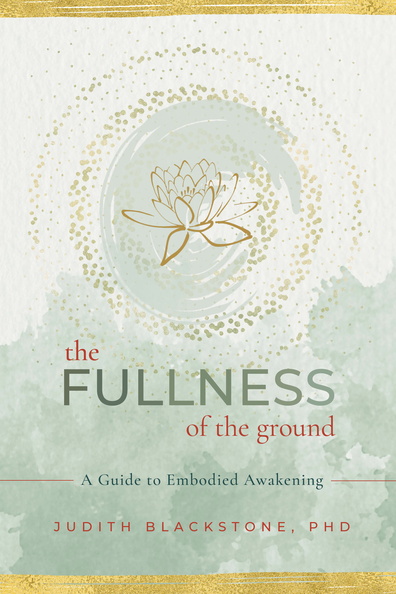
Body and mind are one… with Thich Nhat Hanh
Enjoy this lovely video from our dear friend, Thich Nhat Hanh, recorded at the Body and Mind are One retreat in Colorado in the summer of 2011. There is something about Thich Nhat Hanh’s presence that just allows for an outpouring of mindfulness, love, kindness, and compassion. When we at Sounds True reflect upon mindfulness, we think immediately of our dear friend, Thich Nhat Hanh, and how fortunate we are to have the opportunity to work with him, something we’ve been blessed with over the last 20+ years. In so many ways, he embodies the work we’re doing here: our values, vision, and mission.
The beautiful and inspiring footage we gathered from Body and Mind are One was edited into a seven-hour online course, which you can enjoy from the comfort of your own home, on a schedule that works for you. More than an ordinary training course in mindfulness, Body and Mind Are One is at once a living transmission of insight from this beloved Zen master and a practical teaching series covering fundamental principles for a joyful life.
Poetic Mindset Tip: Your Awe Can Be Connective
POETIC MINDSET TIP: YOUR AWE CAN BE CONNECTIVE
Try applying a mentality of awe when you’re interacting with someone who lives a life very different from yours. Let your awe be the inspiration for a connection. How did they come to believe something that makes you so uncomfortable? What is the root of their behavior? Maybe this person has a dissimilar political view. Maybe they live in a rural town, and you live in a city. Maybe they grew up practicing a particular religion, and you didn’t. These are the big facts that surround the difference between you, but maybe this contrast can be intriguing instead of off-putting? When I find myself on a disparate page from someone else, I try not to close up. I try to lean in to discovery. It’s frequently these occasions that surprise me the most and give me new insight.
When I let myself stay curious about another person’s point of view instead of shutting down, I’m challenged to see with a new lens—and that feels creative. What would I have overlooked if I hadn’t led with a sense of reverential respect? For example, through Poem Store, I developed very unlikely friendships that are still a huge part of my life.
From a familial bond with a timber baron to a deep camaraderie with a wealthy businessman, I found myself open to all kinds of folks I might normally shut out if I weren’t in the mode of poetic openness.
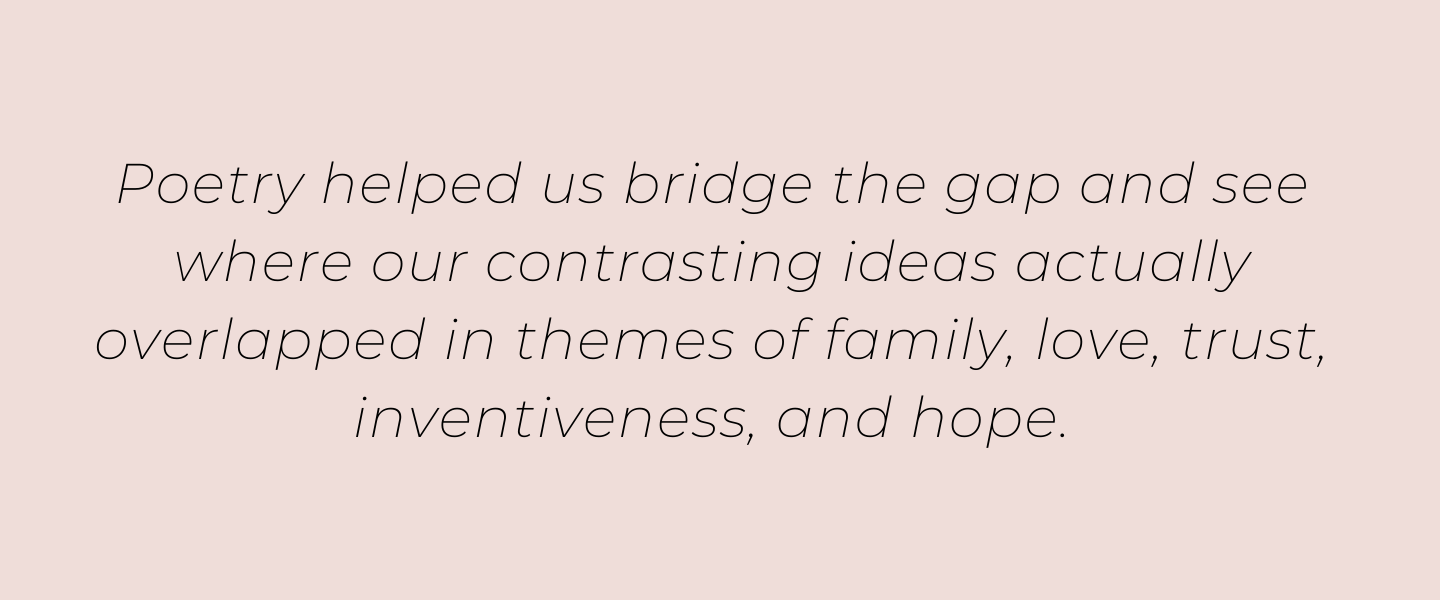
These relationships continue to teach me how to develop compassionate language and an availability for dialogue that focuses on similarities, respect, and humanity, as opposed to difference, disdain, and judgment.
Letting your interest in a person’s inner world outweigh your differences could have unifying results. Awe is often the key to the similarities we all share. It’s our curiosity that links us, and these connections can cause the largest transformations.

Housemates
Pierre Talón lives
in the kitchen,
close to the kettle
with an invisible web.
His brothers and sisters
share the same name.
Long glass-like legs
and dark teardrop bodies.
Penelope is on the front porch,
blending with the potted plant,
her green abdomen longer each day,
her hind legs like mechanical armor.
Pierre Talón catches the flies
and Penelope reminds me
to pause, peering between blossoms.
The spider never leaves, just changes
corners and sizes, and dodges the steam
when I make tea. The grasshopper
greets me for months, until one day
she sheds her skin and leaves me
with a perfect paper version of herself.
This is an excerpt from Every Day Is A Poem: Find Clarity, Feel Relief, and See Beauty in Every Moment by Jacqueline Suskin.
 Jacqueline Suskin has composed over forty thousand poems with her ongoing improvisational writing project, Poem Store. She is the author of six books, including Help in the Dark Season. Her work has been featured in the New York Times, the Atlantic, and Yes! magazine. She lives in Northern California. For more, see jacquelinesuskin.com.
Jacqueline Suskin has composed over forty thousand poems with her ongoing improvisational writing project, Poem Store. She is the author of six books, including Help in the Dark Season. Her work has been featured in the New York Times, the Atlantic, and Yes! magazine. She lives in Northern California. For more, see jacquelinesuskin.com.
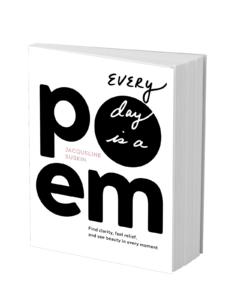
Sounds True | Amazon | Barnes & Noble | Indiebound | Bookshop
Pain as the Path
The wounds, scars, and pain we carry as men have a place in our lives. A function that can lead us directly to the core of deep meaning and fulfillment and provide a positive path forward. This is what initiation was supposed to teach us as men—how to descend into the depths of our own darkness and return a more complete and contributive participant in society.
However, this is where a man’s real problem resides: He has not been taught the skill or alchemy of initiation. He has not learned how to deal with his pain, or the pain of the world, and so he bucks against it.
I realized over the years of grappling with how to heal that not only was I ill-equipped to deal with the hurt I’d been given, but I also seemed to be woefully ill-equipped to reconcile with, and put a halt to, the perpetual hurt I passed on to others. Like many men, I was good at inflicting pain—and men who are good at something tend to do that thing a lot.
Not only was I undereducated in the alchemical craft of turning pain into purpose, but almost every man I knew was in relatively the same situation. Most men simply haven’t been taught how to deal with their pain and use it to become something better.
And this aspect of the journey is the missing link in male initiation, which has historically played the role of guiding a man through the transitory period between adolescence and adulthood, teaching him the skills of discipline, sovereignty, and the ability to face some of the most challenging aspects of his own life.
In fact, I began to see that not only have most men not been given the tools or resources to deal with the pain and suffering in their lives, but we as men are actively taught the opposite—the idiotic tactic of constant emotional avoidance. Not only this, but our emotional avoidance is seen as a theoretical and rational strength in certain circles.
Seeing this brings about a multitude of questions that both illuminate the foundational cracks within current masculine culture and also highlight the work we must embark on if we are to do our individual and collective parts as men in building a thriving society.
There’s more: I began to see the direct correlation between a man’s ability and willingness to face his own darkness and having a clear purpose, deep fulfillment, and clarity of contribution to the things that matter most to him.
But how can we as men give our pain a purpose in a culture where we are largely devoid of emotional permissions? Where the archetype of man, in order to be classified or quantified as a man, must do the impossible task of being brave and courageous without being vulnerable?
This is one of the biggest masculine myths—the false idea that you can be courageous without being inherently vulnerable. When we are rewarded for giving our lives, our hearts, and our emotional bodies up for sacrifice to maintain the illusion of invulnerable strength, we prioritize victory over connection. We praise ourselves for performance in the boardroom, bedroom, and bars, but we lack recognition for our performance in reconciliation, repair, and reparation.
There’s another way. A way where victory is found within the work, and part of that work is facing our own darkness.
Excerpted from Men’s Work: A Practical Guide to Face Your Darkness, End Self-Sabotage, and Find Freedom by Connor Beaton.

CONNOR BEATON is the founder of ManTalks, an international organization dedicated to the personal growth of men. He is a facilitator dedicated to building better men, an entrepreneur, a writer, and a keynote speaker. Connor has spoken to large corporate brands, nonprofits, schools, and international organizations such as the United Nations, Microsoft, Johnson & Johnson, Apple, TED, and Entrepreneurs’ Organization. For more, visit mantalks.com.
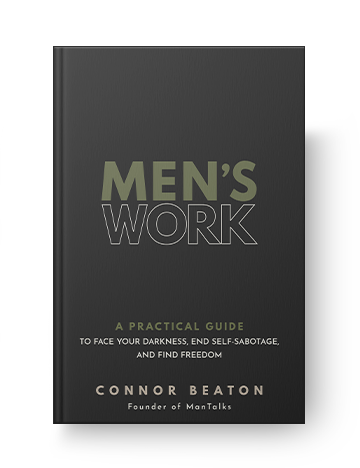
Learn More
Amazon | Barnes & Noble | IndieBound | Bookshop | Sounds True
In Conversation: Pema Chödrön and Alice Walker
What happens when a beloved spiritual teacher and a brilliant author come together to talk about the most tender, compelling aspects of our human experience? The following exchange, excerpted from Pema Chödrön and Alice Walker in Conversation, offers some unexpected answers—and an introduction to the healing practice that has transformed both women’s hearts and lives.
Alice Walker: About four years ago I was having a very difficult time. I had lost someone I loved deeply and nothing seemed to help. Then a friend sent me a tape set by Pema Chödrön called Awakening Compassion. I stayed in the country and I listened to you, Pema ,every night for the next year. I studied lojong mind training, and I practicedtonglen. It was tonglen, the practice of taking in people’s pain and sending out whatever you have that is positive that helped me through this difficult passage.
I want to thank you so much and to ask you a question. In my experience suffering is perennial; there is always suffering. But does suffering really have a use? I used to think there was no use to it, but now I think that there is.
Pema Chödrön: Is there any use in suffering? I think the reason I am so taken by these teachings is that they are based on using suffering as good medicine. It’s as if there’s a moment of suffering that occurs over and over and over again in every human life. What usually happens in that moment is that it hardens us; it hardens the heart because we don’t want any more pain.
But the lojong teachings say we can take that very moment and flip it. The very thing that causes us to harden and our suffering to intensify can soften us and make us more decent and kinder people. That takes a lot of courage. This is a teaching for people who are willing to cultivate their courage.
What’s wonderful about it is that you have plenty of material to work with. If you’re waiting for only the high points to work with, you might give up, but there’s an endless succession of suffering.
Alice Walker: I was surprised how the heart literally responds to this practice. You can feel it responding physically. As you breathe in what is difficult to bear, there is initial resistance, which is the fear, the constriction. That’s the time when you really have to be brave. But if you keep going and doing the practice, the heart actually relaxes. That is quite amazing to feel.
Pema Chödrön: When we start out on a spiritual path, we often have ideals we think we’re supposed to live up to. We feel we’re supposed to be better than we are in some way. But with this practice you take yourself completely as you are. Then ironically, taking in pain—breathing it in for yourself and all others in the same boat as you are—heightens your awareness of exactly where you’re stuck. Instead of feeling you need some magic makeover so you can suddenly become some great person, there’s much more emotional honesty about where you’re stuck.
Alice Walker: I remember the day I really got it that we’re not connected as human beings because of our perfection, but because of our flaws. That was such a relief.
Pema Chödrön: Rumi wrote a poem called “Night Travelers.” It’s about how all the darkness of human beings is a shared thing from the beginning of time, and how understanding that opens up your heart and opens up your world. You begin to think bigger. Rather than depressing you, it makes you feel part of the whole.
Alice Walker: … Everybody is in that boat sooner or later, in one form or other. It’s good to feel that you’re not alone.
Pema Chödrön: I want to ask you about joy. It’s all very well to talk about breathing in the suffering and sending out relief and so forth, but did you find any joy coming out of this practice?
Alice Walker: Oh, yes! Even just not being so miserable. Part of the joyousness was knowing we have help. It was great to know that this wisdom is so old. That means people have had this pain for a long time; they’ve been dealing with it, and they had the foresight to leave these practices for us to use. I’m always supported by spirits and ancestors and people in my tribe, whomever they’ve been and however long ago they lived. So it was like having another tribe of people, of ancestors, come to the rescue with this wisdom that came through you and your way of teaching.
Pema Chödrön: I think the times are ripe for this kind of teaching.
Alice Walker: Oh, I think it’s just the right medicine for today. You know, the other really joyous thing is that I feel more open, I feel more openness toward people in my world. It’s what you have said about feeling more at home in your world. I think this is the result of going the distance in your own heart—really being disciplined about opening your heart as much as you can.


